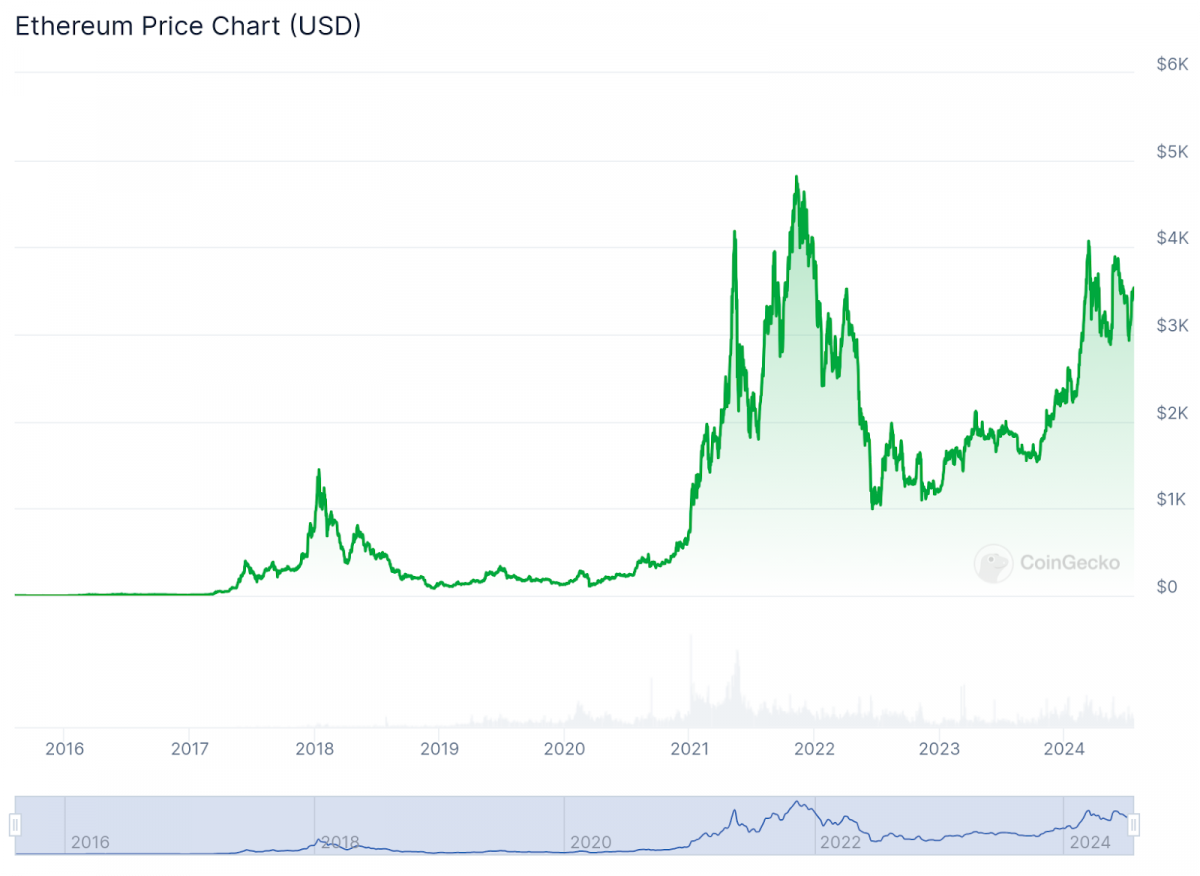From $0.42 to $4,800: The Fascinating Evolution of Ether and Its Market Trends
In Brief
Launched in 2015, Ether emerged as a groundbreaking blockchain initiative that transformed the cryptocurrency landscape through the introduction of smart contracts and decentralized applications, swiftly ascending to become the second-largest digital currency by market cap.

Ever since its debut in 2015, Ether has charted an impressive course, fundamentally altering the cryptocurrency realm and surging to the ranking of the second-largest digital asset by market capitalization. This blockchain project was initiated by brilliant minds led by Vitalik Buterin, who introduced smart contracts and decentralized applications, setting new benchmarks for the blockchain sector.
This evolution set Ether apart from Bitcoin and other cryptocurrencies, establishing it as a robust platform for decentralized apps and enabling a flourishing ecosystem of blockchain-centric enterprises.
This comprehensive article will delve into the significant events, technological breakthroughs, and market dynamics that have impacted Ether’s pricing trends over the years, offering insights into the elements driving its price fluctuations and possible future directions.

Photo: CoinGecko
The Early Days: 2013-2016
Conception and Launch
The inception of Ether traces back to late 2013, when Vitalik Buterin proposed a blockchain framework designed to facilitate decentralized applications and smart contracts. The cryptocurrency community quickly embraced this groundbreaking idea, culminating in a successful crowdfunding campaign in August 2014.
With Ether’s official debut on July 30, 2015, a new chapter in the history of blockchain was written. At that time, Ether (ETH), its native currency, was valued at just $0.42, reflecting the project's nascent phase and a lack of appreciation for its broader potential.
First Year of Trading
During the majority of its initial year, ETH started trading at around $0.75 and rarely crossed the $1 mark. With the project still in its infancy, it was a time marked by low awareness and slow adoption. Nevertheless, the groundwork for future advancements was laid as developers and early enthusiasts began to tap into the platform’s capabilities.
2016: Growing Popularity and the DAO Hack
In 2016, Ether began to gain significant momentum. Starting from below the $1 threshold, its price skyrocketed to over $20 by mid-year, primarily driven by heightened interest in what the platform could achieve and the emergence of the first significant DAO built on the Ether infrastructure.
Yet, the bliss did not last long. However, trouble struck in June 2016 when the DAO fell victim to a hack, resulting in the loss of approximately $50 million worth of Ether. This incident sent shockwaves through the Ether community and the wider cryptocurrency market, causing a sudden and steep decline in ETH's value.
The DAO breach triggered a contentious hard fork of the Ether network, giving rise to Ethereum Classic (ETC) and illuminating the challenges of security and governance in decentralized frameworks. Despite this setback, Ethereum demonstrated resilience, finishing the year with a price around $8, showcasing ongoing confidence in the project’s long-term vision.

Photo: CoinGecko
The Bull Run of 2017: Ether Enters the Limelight
The year 2017 marked a turning point for Ether and the entire cryptocurrency landscape. As digital currencies captured public interest, Ether's valuation soared.
First Half of 2017
ETH opened the year priced at approximately $8 and quickly picked up steam, reaching about $400 by June. This astronomical growth stemmed from various factors:
- Growing utilization of the Ether platform across diverse sectors;
- A surge in Initial Coin Offerings (ICOs) utilizing Ether's infrastructure;
- A prevalent bullish sentiment sweeping across the cryptocurrency market.
Second Half of 2017
The latter part of 2017 witnessed even more extraordinary developments. Ether, riding the wave of the broader cryptocurrency euphoria, rocketed to an all-time high of roughly $1,400 by year-end, marking an astonishing increase of over 17,000% since January.
This period of excitement drew significant media coverage and attracted a torrent of new investors, further igniting price speculation. The meteoric rise of Ether during this phase solidified its status as a crucial player within the cryptocurrency ecosystem, reflecting the increasing fascination with blockchain technology and decentralized applications.

Photo: CoinGecko
The Crypto Winter: 2018-2019
The exuberance of 2017 eventually gave way to a harsh reality in 2018, ushering in what became known as the 'crypto winter.'
2018: The Great Decline
Multiple factors contributed to this significant decline:
- Regulatory anxieties in various nations;
- The bursting of the ICO bubble;
- A widespread decline in confidence in the cryptocurrency market;
- Numerous ventures that raised funds via Ether-based ICOs selling off their ETH holdings.
2019: Modest Recovery and Consolidation
The year 2019 brought a slight rebound for Ether, with its price fluctuating between $100 and $300. While this was an improvement from the lows of 2018, it remained far below the lofty heights witnessed during the prior bull run.
This period was characterized by a focus on development within the Ether community, with efforts concentrated on enhancing the platform's scalability and gearing up for the arrival of Ether 2.0—an ambitious upgrade aimed at bolstering the network's efficiency and capability.

Photo: CoinGecko
The DeFi Boom and COVID-19 Impact: 2020
The year 2020 ushered in both challenges and prospects for Ether:
COVID-19 Market Crash
The onset of the COVID-19 pandemic initially wreaked havoc on cryptocurrency valuations, with Ether dipping briefly below $100 in March. Yet this downturn turned out to be temporary.
Recovery and DeFi Boom
As central banks around the globe initiated monetary easing strategies in response to the economic fallout, interest in cryptocurrencies as a safeguard against inflation surged. The emergence of the Ether-driven Decentralized Finance (DeFi) ecosystem began to gain traction, further stimulating demand for ETH.
These factors fueled a remarkable recovery, with ETH finishing the year trading above $700. The DeFi surge particularly bolstered Ether’s desirability, as demand for ETH amplified across various DeFi applications. This phase also attracted increasing attention from institutional investors, providing additional support for prices.

Photo: CoinGecko
The All-Time High and Volatility: 2021
New All-Time High
Bolstered by the ongoing DeFi expansion, rising institutional interest, and the increasing popularity of Non-Fungible Tokens (NFTs)—many of which were created on the Ether platform—ETH soared to a new peak of over $4,800 in November 2021.
Market Volatility
However, the latter half of 2021 was characterized by heightened volatility. Factors contributing to this shifting landscape included:
- Regulatory crackdowns in China;
- Normal market cycles;
- Concerns regarding the ecological effects of proof-of-work mining.
Despite facing these challenges, Ether managed to hold on to much of its value, concluding the year at around $3,700.
Photo: CoinGecko
The Merge and Market Challenges: 2022-2023
2022: A Challenging Year
The cryptocurrency landscape faced substantial difficulties in 2022. Escalating interest rates, inflation worries, and the downfall of significant crypto projects triggered a broad market retreat. Ether's value suffered markedly, occasionally dipping below $1,000 throughout the year.
The Merge
A pivotal technological advancement was achieved in September 2022 with Ether's shift from a proof-of-work to a proof-of-stake consensus mechanism. This upgrade was considered a vital step for the future of Ether, slashing its energy consumption by over 99%. Yet, it didn't yield the immediate price impact many had anticipated. The Merge By 2023, the cryptocurrency market began to show recovery signs, with Ether's price gradually escalating. Contributors to this renewed optimism included:
2023: Signs of Recovery
Ongoing advancements in layer-2 scaling solutions;
- Anticipation of potential Ether ETFs;
- Expanding acceptance of Ether across various sectors.
- By the close of 2023, Ether had regained some footing, trading above $2,000.
The green light for Bitcoin spot ETFs in January 2024 set the stage for increased institutional engagement in the cryptocurrency sphere. This trend, along with expectations surrounding future Ether ETFs, played a substantial role in fostering positive price movement for ETH in early 2024.

Photo: CoinGecko
2024 with Ether Spot ETFs and Beyond
Early 2024 Developments
A significant milestone was reached in late May 2024 with the SEC granting approval for Ether spot ETFs.
Ether Spot ETFs
This landmark decision opened avenues for ETH to be traded on major stock exchanges, potentially ushering in a new influx of institutional and retail investors. Throughout its journey, Ether's pricing has been shaped by several pivotal factors. The increased utilization of Ether for transactions and its integration into diverse industries has significantly fueled demand, thereby contributing to price ascension.

Photo: CoinGecko
Factors Influencing Ether Prices
Investor sentiment is equally crucial. Variations in investor confidence and the overall market mood can trigger significant price shifts for Ether. Positive developments, endorsements, and market trends often cultivate investor enthusiasm, driving prices higher, while negative sentiment or market corrections typically have the opposite effect.
Ether also contends with competition from a multitude of other digital assets and blockchain platforms. Innovations and advancements from rival cryptocurrencies can sway Ether’s market share and influence its valuation, as investors may look towards perceived superior alternatives.
Technological upgrades and advancements, such as the bridge to Ether 2.0 and the enactment of EIP-1559, have substantially affected Ether’s market dynamics and pricing.
The regulatory framework is another critical element. The evolving landscape of cryptocurrency regulations across different regions plays a vital role in determining trends in Ether’s market. Regulatory changes can sway investor behavior, with shifts in legislation potentially affecting Ether’s accessibility, legality, and overall market performance.
Broader macroeconomic factors, including worldwide economic conditions, inflation rates, and monetary policies, contribute to Ether’s perceived worth.
From a mere $0.42 to a staggering $4,800: The Incredible Evolution of Ether's Market Metaverse Post
Disclaimer
In line with the Trust Project guidelines Launched in 2015, Ether, a pioneering blockchain venture, redefined the cryptocurrency landscape with its innovative smart contracts and decentralized applications, quickly climbing to the rank of the second-largest digital asset based on market capitalization.







